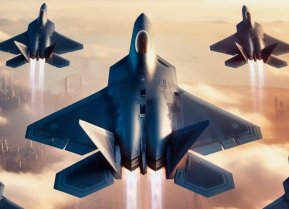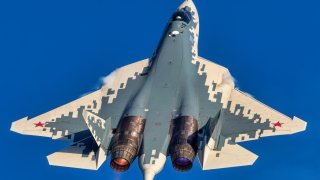Russia's Su-57 Fighter vs. NGAD: One Will Actually Be 'Sixth Generation'
Russia is making some pretty bold claims regarding the Su-57 stealth fighter. And yet, it won't come close to matching up against NGAD.
Russia's Su-57 vs. NGAD: It would be unwise to dismiss all Russian military hardware out of hand. While jokes can still be made that a hammer is the tool typically employed to repair its tanks and that its submarines are better at diving than surfacing, the fact remains that the former Soviet Union managed to produce some truly advanced aircraft.
The Kremlin has continued that tradition, and the Sukhoi Su-57 (NATO reporting name "Felon") is currently one of only four "fifth-generation" fighters built to date – the others being the Lockheed Martin F-22 Raptor, Lockheed Martin F-35 Lightning II, and the Chengdu J-20 (NATO reporting name "Fagin").
Yet, where Moscow often loses creditability is that it all too often overhypes even its very best aircraft – and looks almost stupid in the process.
The Su-57 in the Crosshairs
The Kremlin boasted that its Su-57 employs composite materials including polymer, fiberglass, and aluminum load-bearing honeycomb fillers. It also featured an aerodynamic configuration that includes a pair of internal weapons bays, which help provide a low level of radar and infrared signature.
Each of the aforementioned bays was designed to carry up to four K-77M beyond visual range radar-guided missions. In addition, the Su-57 can carry a pair of K-74M2 short-range infrared-guided missiles in underwing fairings, but at the expense of its stealth.
According to Air Force Technology, the Russian aircraft is also equipped with 3D thrust vector jets for higher maneuverability and is capable of developing supersonic cruising speed. The twin-engine fighter is powered by Izdeliye 117 or AL-41F1 augmented turbofans, and it can fly at a speed of up to Mach two without afterburners, while it can reach a range of up to 3,500km at subsonic speeds.
The Su-57 has been further noted to employ a powerful onboard computer – which has been described as an electronic second pilot – while its radar system is spread across its body. Its onboard avionics systems include active electronically scanned array (AESA) radar and ELINT systems.
Sixth-Generation Claims
Russia has further suggested that an upgraded and even more advanced model of the Su-57 could be in the works and that it would be the world's first in-service "sixth-generation" aircraft.
This was first noted in a November 2017 report from Russian state media outlet Tass, which cited Russian Aerospace Force ex-commander and Chairman of the Federation Council Defense and Security Committee Viktor Bondarev, who explained, "This is actually a splendid plane and it can embrace both fifth-and sixth-generation features. It has huge modernization potential. Importantly, it is the best among the existing versions of its stealth characteristics. It incorporates all the best that is available in modern aviation science both in Russia and in the world."
Yet, even as Russia continues to tout the aircraft, Western aviation experts have suggested the Su-57 is mostly hype – and that Moscow lacks the manufacturing capabilities even to produce the aircraft in significant numbers. That has been noted by the fact that the Su-57 first flew in January 2010 but didn't enter service until December 2020.
How Does the Su-57 Stack Up to the NGAD
First conceptualized back in 2014 in a DARPA's Air Dominance Initiative study, the United States Next Generation Air Dominance (NGAD) program is designed to achieve air superiority, yet, the NGAD shouldn't be seen as simply a single aircraft.
Last month, at the POLITICO Defense Summit, U.S. Air Force Secretary Frank Kendall explained that the manned NGAD aircraft will control the uncrewed fighters escorting it. A variety of multi-mission drones, which have been dubbed Collaborative Combat Aircraft (CCA), could act as loyal wingmen, while all of the aircraft could be networked together enhancing the situational awareness for the manned and unmanned craft alike.
Moreover, as previously reported by Maya Carlin, there are likely five different technologies that will be prioritized in the NGAD's fighter design including advanced weapons, stealth, digital design, propulsion, and thermal management. While sixth-generation technology has not been precisely defined, the features in the NGAD program are expected to exceed the capabilities of fifth-generation counterparts.
Therefore it would still seem like quite the leap that the Su-57, or any fifth-generation fighter for that matter, could be upgraded to a sixth-generation fighter so easily.
The next generation will likely include advanced digital capabilities, including highly-capable artificial intelligence (AI), data fusion, and battlefield, command, control, and communications (C3) capabilities; will be optionally manned; employ enhanced human-systems integration with virtual cockpits; advanced stealth airframes and avionics; advanced variable-cycle engines; increased-range stand-off and BVR (beyond visual range) weapons; and even be equipped with directed-energy weapons such as laser CIWS (close-in weapons systems).
Is the Su-57 Even Fifth-Generation?
Finally, some Western analysts have even suggested that Russia's Su-57 fighter has a design that is much closer to an advanced fourth-generation fighter than a true fifth-generation aircraft.
Its stealth is nowhere near as effective as that of the F-22 Raptor or F-35 Lightning II. It may be less detectable than an F-15 Eagle or F-16 Fighting Falcon, but the Su-57 simply has a poor cross-section compared to its main fifth-generation rivals.
In conclusion, the Su-57 may be a very capable aircraft – even if Russia doesn't have all that many in service – but it simply can't be considered sixth-generation when it is barely a fifth-generation fighter.
Author Experience and Expertise
Peter Suciu is a Michigan-based writer. He has contributed to more than four dozen magazines, newspapers, and websites with over 3,200 published pieces over a twenty-year career in journalism. He regularly writes about military hardware, firearms history, cybersecurity, politics, and international affairs. Peter is also a Contributing Writer for Forbes and Clearance Jobs. You can follow him on Twitter: @PeterSuciu.


